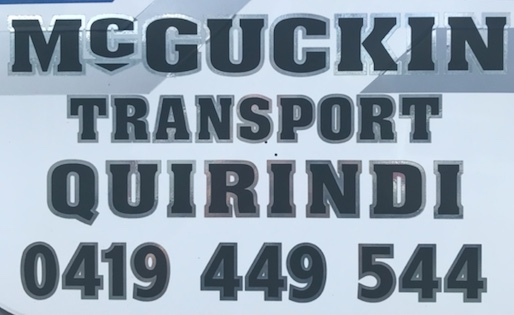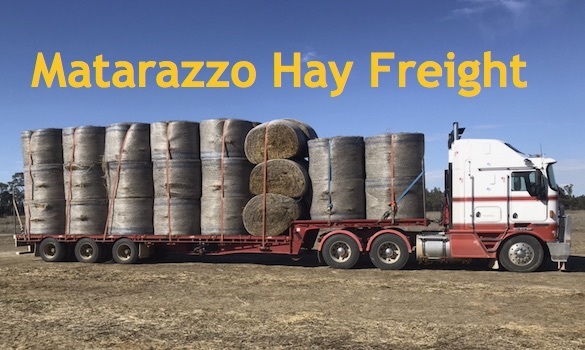VFF says non-compliance will threaten the future of the drought Road Train network
- By: "Farm Tender" News
- Water & Irrigation News
- Dec 15, 2019
- 1175 views
- Share

This article is bought to you by McGuckin Transport and Mazaratto Hay Freight.
The drought roadtrain network has been a big win for growers, improving the efficient movement of hay and grain to drought affected farmers.
Reports of non-compliance, however, threaten the future of the drought roadtrain network.
If you (or a transport operator you know) is intending to utilise the network ensure you are across the requirements:
Drought roadtrain network factsheet:
The Road-Train Network in the North West of Victoria
Introduction
The bulk of Road-Trains operating in the North West of Victoria either originate in New South Wales or service transport companies in that State. It is therefore important that the access arrangements are consistent across the borders. To that end, Victoria has harmonised its operating conditions and mass and dimension limits for Road Trains operating in the North West of the State to reflect those conditions and limits allowed in New South Wales.
What are the specific mass limits and axle spacings?
The mass limits for Road-Trains operating on the network are as follows:
• Steer Axle – 6.0 tonnes
• Steer Axle – 6.5 tonnes (where the tyre section width is at least 295mm)1
• Steer Axle – 6.7 tonnes (where the tyre section width is at least 375mm)
• Drive Axle or Tandem Axle Group (Dolly) – 16.5 tonnes (General Mass Limits)
• Drive Axle or Tandem Axle Group (Dolly) – 17.0 tonnes (Concessional or Higher Mass Limits)
• Tri-Axle Group – 20.0 tonnes (General Mass Limits)
• Tri-Axle Group – 21.0 tonnes (Concessional Mass Limits)
• Tri-Axle Group – 22.5 tonnes (Higher Mass Limits)
• Overall – 79.5 tonnes (General Mass Limits)
• Overall – 81.5 tonnes (Concessional Mass Limits)
• Overall – 85.5 tonnes (Higher Mass Limits)
1 If the tyre section width is less than 295mm the steer axle may still be 6.5 tonne as long as the prime movers meet the conditions set out in Schedule 3 of the Heavy Vehicle (Mass, Dimension and Loading) National Regulation.
2 If the combination has an axle spacing that is less than those stated above or exceeds the maximum trailer limits of 7.23 metres and 7.32 metres a bridge assessment will be required.
Ad - McGuckin Transport - Quality Grain and Hay Transporters - Ad
Ad -Need to shift some Hay? Try Mazaratto Hay Freight, Singles, Doubles, Triples, Big or Little Squares, Rolls, North or South. Give them a try - Ad
In relation to axle spacings, the combination must meet the following minimum and maximum axle spacings to safely cross all the structures on the network (the figures are in metres):2
What are the specific dimension limits?
The dimension limits for road trains operating on the expanded network are as follows:
• Maximum Length – 36.5 metres
• Maximum Height – 4.3 metres (for combinations not transporting livestock)
• Maximum Height – 4.6 metres (for livestock combinations – see conditions below)
• Maximum Width – 2.5 metres
What are the operating conditions on the expanded network for livestock and non-livestock vehicles?
In a bid to establish cross-border consistency, the operating conditions for Road-Trains has been harmonised with those operating conditions that apply to Road-Trains operating in New South Wales.3
3 More information on New South Wales’ conditions for the operation of Road-Trains can be found here: https://www.rms.nsw.gov.au/business-industry/heavy-vehicles/road-access/restricted-access-vehicles/r...
4 In line with New South Wales Modular B-Triples that are given access to Victoria’s Road-Train network do not need to be enrolled in IAP. However, B-Triples and AB-Triples that are provided access to the network do need to be enrolled into IAP.
In light of that, Road-Train operators transporting livestock under the expanded network must provide proof that the company and driver are enrolled in the New South Wales Livestock Loading Scheme.
For Road-Train combinations that do not transport livestock, the following conditions apply:
• When operating at Higher Mass Limits (85.5 tonnes), the road train is fitted with a GPS device accredited under the Intelligent Access Program (IAP);4
• When operating at Higher Mass Limits, the road train (prime mover and trailers) is accredited under the Mass Management module of the National Heavy Vehicle Accreditation Scheme;
• When operating in excess of 20.0 tonnes on a tri-axle group, certified Road Friendly Suspension (RFS) is fitted to the road train;
• The road train does not exceed a speed of 90 km/h or any lower speed limit applying to the route;
• The drawbar length on the road train is not less than 3.0 metres; and
• The road train displays a “road train” warning sign at the front and rear.
Ad - McGuckin Transport - Quality Grain and Hay Transporters - Ad
Ad -Need to shift some Hay? Try Mazaratto Hay Freight, Singles, Doubles, Triples, Big or Little Squares, Rolls, North or South. Give them a try - Ad
Where Can I Operate?
As noted, the approved network is for Road-Trains operating in the North West of Victoria. Routes approved under that network can be found here.
The Road-Train Network in the North West of Victoria
Do I need a permit to operate on this network?
If you are operating on roads marked as orange on the network you will require a permit to operate.
The limited number of roads marked as green are in Mildura and adjoin the New South Wales border. These green roads are covered in Schedule 4 of the National Class 2 Heavy Vehicle Road Train Authorisation (Notice) 2014 and therefore access to this small network does not require a permit.
Can I operate a Road-Train that doesn’t match the above axle-spacings?
Yes, you may apply to operate a Road-Train that doesn’t comply with axle-spacings stated above. This combination, however, will need a bridge assessment to ensure it can safely operate across the structures in the North West of the State. Please note that this assessment takes between 1 to 2 weeks.
The operating and dimension conditions stated above also apply.
Can I operate a Road-Train with a tri-axle dolly or a B-Triple?
As with a Road-Train that doesn’t comply with the axle-spacing you may also apply for other combination types, whether it’s a Road-Train with a tri-axle group, a B-Triple or an A-B-Triple combination. Again, these combinations will require a bridge assessment that generally takes between 1 to 2 weeks to complete.
The operating and dimension conditions stated above also apply.
Please note that the combinations longer than 36.5 metres will not be considered.
Where can I apply for a permit?
Class 2 heavy vehicle permits can be obtained from the National Heavy Vehicle Regulator via their Portal.
If the combination complies with the mass, axle-spacings, dimensions limits and operating conditions above the NHVR will issue a permit as soon as practicable.
Can I cross rail level crossings?
The network features a number of active rail level crossings including those at Ouyen, Managatang and Swan Hill.
In line with the Transport (Compliance and Miscellaneous) Act 1983, heavy vehicles that exceed 26.0 metres in length require a permit before they are allowed to cross a rail level crossing.
Consequently, prior to operating the combination, the registered owner must obtain a permit from the Over Dimension Load team as part of the Department of Economic Development, Jobs, Transport and Resources. Applications stating the length of the Road-Train and the time of day(s) of the journey must be sent to odlpermit@ecodev.vic.gov.au. Please be aware that applications can take up to five days to process.
Ad - McGuckin Transport - Quality Grain and Hay Transporters - Ad
Ad -Need to shift some Hay? Try Mazaratto Hay Freight, Singles, Doubles, Triples, Big or Little Squares, Rolls, North or South. Give them a try - Ad
For more information please contact the following number – (03) 8392 7720. (More information can also be found at the Department’s website).
Arrangements for Road Trains Transporting Hay and Feed to Drought Affected Areas in New South Wales & Queensland
In addition to the above, for the purposes of transporting Hay and Feed to drought affected farms in New South Wales and Queensland, we have expanded the Road-Train network to include the route south of Ouyen to Horsham, from Warracknabeal to Dimboola and from Dimboola to the South Australian border. Permits to operate will be for a six-month period and operators will be required to comply with the following conditions:
Hay
• The height of the combination not to exceed 4.6 metres;
• The width of the combination not to exceed 2.83 metres;
• The mass of the combination not to exceed the GML mass for that combination (e.g. 79.5 tonnes for a Road-Train, 83.0 tonnes for a B-Triple, etc)
• Operators comply with the Guidelines for transporting hay and the operating conditions outlined in this document.
Feed
• The height of the combination not to exceed 4.3 metres;
• The width of the combination not to exceed 2.5 metres;
• The mass of the combination not to exceed the HML mass for that combination (e.g. 85.5 tonnes for a Road-Train, 91.0 tonnes for a B-Triple, etc)5
• Operators comply with the operating conditions outlined in this document.
5 Combinations operating at HML will need to be fitted with IAP
Note: All permit applications must also include first mile access requests.
Ad - McGuckin Transport - Quality Grain and Hay Transporters - Ad
Ad -Need to shift some Hay? Try Mazaratto Hay Freight, Singles, Doubles, Triples, Big or Little Squares, Rolls, North or South. Give them a try - Ad
 .
. 











Share Ag News Via